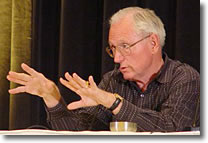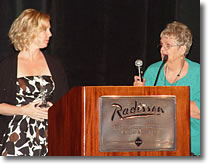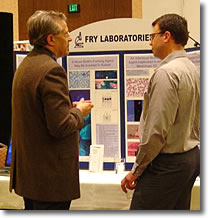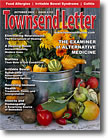Page 1, 2
The thinking about autism and Lyme disease is moving so quickly, it can make your head spin.
Last year, and again this year, doctors at the Lyme-Induced Autism (LIA) Foundation's annual conference shared perspectives from the front lines of a battle against mostly unseen, devastating pathogens that rob the afflicted of the promise of a healthy life.
The most striking difference was that last year, the doctors flashed on the big screen lots of patients' slides revealing genetic testing and lab results. This year, there were almost none. The doctors who had "been there, done that" found that the tests didn't really help that much.
The Tyranny of Tests
"Our testing is not that great," offered Dr. Jeff Wulfman of Vermont. "We must rely on the patient's history. That more often leads to the diagnosis. There often is no gold standard to measure." He cited several studies, including a 2002 study of 80 internal medicine outpatients that found that history led to the final diagnosis 76% of the time, whereas the physical examination and laboratory investigation led to the final diagnosis 12% and 11% of the time, respectively.1
Dr. Jeff Wulfman of Vermont received the "2009 Physician's Excellence Award" from the LIA Foundation and CHOICE. |
 |
Immune-system suppression is common in afflicted patients. That makes for a poor antibody response. Blood is the easiest thing to pull out and measure; but spirochetes, for example, prefer to set up housekeeping in the tissues, so often they cannot be found in the blood. Hence, a western blot test will be "negative" for many people with chronic Lyme disease. Short of an autopsy, we can't sample tissue, bone, organs, or other places where microorganisms live. Blood simply isn't a good indicator of the pathogenic load in the human body.
 "Mayo Clinic said no test is adequate today to rule in or out the presence of Lyme other than the doctor's opinion," added Dr. Garry Gordon of Arizona. "Yet people spend a great deal of money trying to find out which pathogen they harbor. Truth is, we all carry a burden of pathogens." "Mayo Clinic said no test is adequate today to rule in or out the presence of Lyme other than the doctor's opinion," added Dr. Garry Gordon of Arizona. "Yet people spend a great deal of money trying to find out which pathogen they harbor. Truth is, we all carry a burden of pathogens."
Testing for heavy metals is a challenge. Often, autistic children do not excrete metals, so tests on hair samples, for example, can look as if there are low levels when actually they just mean that the metals are simply not being released.
 |
Tami Duncan of the LIA Foundation and Linda Heming of CHOICE (Consumers for Healthcare Options, Independence, Choice and Experience) cosponsored the June 2009 convention in Scottsdale, Arizona. |
Epigenetics
The hit-and-miss reality of testing is compounded when epigenetic changes are considered. Genetic expressions are changed by mechanisms other than alterations in the underlying DNA sequence. Additionally, these changes may remain through cell divisions for the remainder of the cell's life and last for multiple generations.
Dr. Gordon cited a study from China in 2003 that found that cells infected with the tuberculosis organism changed 463 new expressions of genes.2 Bisphenol A (BPA), a chemical used in polycarbonate plastic and epoxy resins, has been found to cause an epigenetic change in mice, making lean mice into obese mice.3
Dr. Wulfman asks, "When you map the genes, are you seeing a cause or simply a marker?" Good question.
The Body Burden of Pathogens
"Toxins are now believed to be a significant contributor to most chronic diseases today," Dr. Gordon said.
| Donna Jackson Nakazawa, author of the book The Autoimmune Epidemic, makes the case that the human immune system is under bombardment. "Our own immune system is being asked to distinguish between itself and invaders, and it is making too many mistakes because of the plethora of environmental chemicals," she said. "In the international community, scientists talk about the impact of the chemicals as global warming, yet we do not admit that there is a sea of change also taking place in human bodies." |
|
Studies done by the CDC (Centers for Disease Control and Prevention) and Environmental Working Group document that we all harbor a surfeit of chemicals, from fire retardants and pesticides to plastics and aluminum, and more. Today's children come into the world with a heavy body burden. "I am amazed at how much heavy metal toxicity little children have at 5–6 years of age," reported Dr. Ann Corson of Pennsylvania.
"You can test, but we know everyone born today has 1000 times more lead in their bones," said Dr. Gordon. "As the mother creates a fetus, the calcium from the mom is used to make bones in the fetus but the lead in the bones is downloaded too." If the mother has amalgam (mercury) fillings, that mercury is downloaded to the fetus. And on it goes.
"These kids cannot detox what they downloaded as a fetus from their mothers plus what they get on their own," added homeopath Mary Coyle.
Mercury and lead are extremely neurotoxic and cytotoxic, but their combined synergistic effect is much worse. "When you put mercury and lead together it is not 1 + 1 = 2. No, it is 1 + 1 = 100 times more toxic," Dr. Wulfman explained. "Modern medicine tries to isolate one factor, but there is never just one."
Mercury holds a special place in the world of toxins. "Mercury, in my experience, is the one thing that most fuels the growth of pathogens," stated Dr. Lee Cowden of Texas. "It is slow to detoxify."
Testosterone has an affinity for mercury, which sheds light on why more boys than girls are autistic.

|
Dr. Doris Rapp, best-selling author of Is This Your Child? and Our Toxic World, received a lifetime achievement award from the LIA Foundation and CHOICE in recognition of her dedication to education about the harmful effects of environmental toxins. |
Smart Bugs
The microbe community is highly sophisticated, and very capable of adapting to survive. Over time, they increase their survival odds by morphing their modes of transmission. Lyme disease, for example, was originally known as a "tick-borne disease." But Lyme spirochetes have been found in semen and breast milk, and congenital Lyme disease can be passed by an infected mother to the fetus through the placenta during pregnancy.
 "Most of the autistic children are cases of Lyme disease contracted congenitally," said Dr. Dietrich Klinghardt of Washington. "Most of the autistic children are cases of Lyme disease contracted congenitally," said Dr. Dietrich Klinghardt of Washington.
He also stated that almost all of his Lyme patients have kryptopyrroluria (KPU). "There are 300 enzymes that are zinc dependent," Dr. Klinghardt explained. "The bugs figured out to block one of these enzymes to make you pee out your zinc and disarm your immune system. It is genius! It is one of the bugs' molecular mechanisms that has not been found yet, but we know they can do it. If you do not have zinc, the body substitutes cadmium or lead or aluminum or mercury. When the substitution is made, the child becomes highly toxic. Autistic kids cannot mobilize mercury, cannot get it out. With KPU treatment, they can."
Dr. Wulfman cited studies showing that parasites actually make us do things that insure their survival. "We see carb cravings with Lyme disease. That is because the parasites love sugar and have mind control over us to make us deliver it."
The bugs are also skilled at recruiting heavy metals to create an ingenious cloaking device called biofilm.
The Genius of Biofilm
Bacteria aggregate, then draw upon calcium, magnesium, iron, heavy metals, fibrin, and other elements to weave a protective polymeric matrix around themselves: biofilm. Inside the filmy structure, bacteria can shed their outer membrane proteins (OMPs). Without these, they have no proteins to serve as antigens or as targets of the immune system. Biofilms leach toxins into the bloodstream, which weaken the immune system while shielding the pathogens and facilitating communication among the community of microorganisms that live in the matrix. Biofilms can even develop "water channels" that distribute nutrients among the pathogen communities. When biofilms exist in the gut, they disturb digestion and prevent normal flora from thriving. Bacterial are very crafty in creating methods to survive, procreate, and hide from both the immune system and antibiotics.
Biofilms cause more than 70% of community and hospital-acquired infections, according to the CDC.
Peta Cohen, MS, RD, reported in May 2009 that biofilms are a huge piece of the puzzle in autism, lupus, Lyme disease, multiple sclerosis, and any autoimmune-type chronic infection.4 Others agree, including Dr. Stephen Fry of Arizona.
"Biofilms are the law in nature, not the exception," Dr. Fry said. "Biofilm colonies are complex, difficult to treat. We do not have biofilm drugs yet today."
Biofilm compels the immune system to maintain a state of dysfunction.
 |
Dr. Stephen Fry, left, is pioneering research into biofilm. |
The Infectious Disease Society of America (IDSA) has been in a running battle with the International Lyme and Associated Disease Society (ILADS), resisting the use of long-term antibiotics to knock out chronic Lyme disease. But what if IDSA more or less has it right – that long-term antibiotics are not the answer?
One of the best-known features of biofilms is that pathogens within a biofilm community are 100 to 1000 times more antibiotic resistant.5-7 Dr. Klinghardt advised: "It is not enough to bombard with antibiotics. We have to change the inner environment and detox."
Dr. Gordon agrees. "If we give full antibiotics at the start of the bull's-eye rash, it just kills the easy ones and leaves the rest antibiotic resistant."
Dr. Anju Usman of Illinois reported that she has had success dismantling biofilm with EDTA and enzymes. "Biofilm requires formation of fibrin. Nattokinase penetrates the GI tract and gets into the blood where it breaks down fibrin." The battle with MRSA also showed the effectiveness of chelating factors. "One of the most effective drugs against MRSA is vancomyecin," she continued. "But they couldn't get rid of it; there was a biofilm. Then when they combined the antibiotic with EDTA, it pulled the calcium, magnesium, and iron and dismantled the biofilm."
Many Pathogens? or Maybe Just One?
Dr. Fry spends many of his days tethered to a microscope. He prods us to rethink what we know about the bugs that trigger chronic disease symptoms. He thinks the day is not far off when we may recognize that a single microorganism, cloaked in biofilm, is responsible for symptoms of Lyme disease, its coinfections, and many other expressions of chronic disease.
"I don't think Borrelia is the main problem in Lyme disease. We only have one picture of it in the thousands of slides that have gone through our lab. There is something that stains like bacteria, and looks like bacteria in people who are sick. Almost all the sick patients have evidence of more than one pathogen, and evidence of biofilms. There is more than one pathogen in the biofilm community, but one particular microorganism we've stained may be the main concern."
Six years ago, he established Fry Laboratories in Scottsdale to begin to identify the DNA of this pathogen. "So far, we have mapped three unique genes that make up this particular microorganism," he said. "These genes are unique to this pathogen; no other entity on earth is known to possess them. As our work progresses, we will be able to further identify the genetic makeup of this pathogen and then develop a reliable test for it."
But if one bug is behind so much chronic disease, why so many different diagnoses and symptoms? "In the biofilm community, there is a soup of pathogens where they all hide. Any one of those pathogens may not be why you are sick. For example, just about everybody over 35 will test positive for Epstein-Barr virus, but people usually are not sick from it. So not every bug in the biofilm soup is causing symptoms. Symptoms may vary based upon a person's genetics, environment, and pathogen genotype."
Dr. Wulfman also questions the concept of a multitude of bacteria causing a multitude of different diseases. "Classic Lyme disease – the person had no prior infection, got a tick bite – I don't see that as much anymore," he said. "I am not comfortable with ‘Lyme disease' to cover this entire spectrum of illness related to Borrelia. As we see more coming out about the ubiquitous nature of organisms in people today, I see us and the community of microbes within us, and our immune system, trying to manage that. It is a constant tug and pull."
Page 1, 2
|



![]()
![]()
![]()


 "Mayo Clinic said no test is adequate today to rule in or out the presence of Lyme other than the doctor's opinion," added Dr. Garry Gordon of Arizona. "Yet people spend a great deal of money trying to find out which pathogen they harbor. Truth is, we all carry a burden of pathogens."
"Mayo Clinic said no test is adequate today to rule in or out the presence of Lyme other than the doctor's opinion," added Dr. Garry Gordon of Arizona. "Yet people spend a great deal of money trying to find out which pathogen they harbor. Truth is, we all carry a burden of pathogens."

 "Most of the autistic children are cases of Lyme disease contracted congenitally," said Dr. Dietrich Klinghardt of Washington.
"Most of the autistic children are cases of Lyme disease contracted congenitally," said Dr. Dietrich Klinghardt of Washington.
